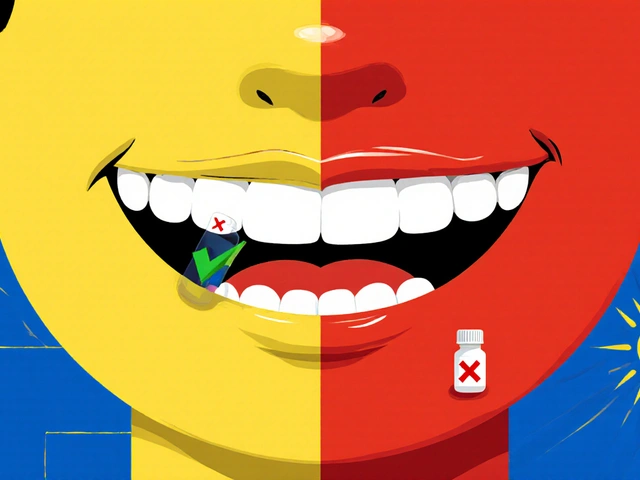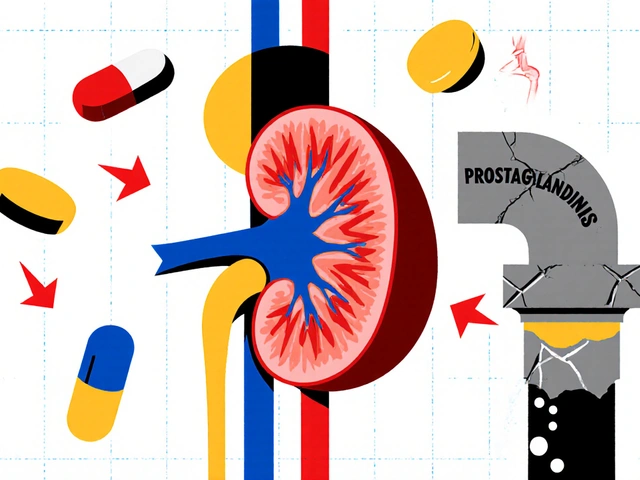NSAID Kidney Risk Calculator
Assess Your NSAID Kidney Injury Risk
This tool calculates your 30-day risk of kidney injury based on 12 key factors. For best results, consult your doctor.
Your Risk Assessment
Personalized Recommendations
Every year, tens of thousands of people end up in the hospital with sudden kidney damage-not from a rare disease, not from an accident, but from something they bought off the shelf: ibuprofen, naproxen, or aspirin. These are NSAIDs, the go-to pain relievers for headaches, back pain, arthritis, and sports injuries. For most people, they’re harmless. But if you have kidney disease, are over 60, take blood pressure meds, or just don’t drink enough water, even a few pills can trigger acute kidney injury-and you might not even know it until it’s too late.
How NSAIDs Actually Hurt Your Kidneys
NSAIDs work by blocking enzymes called COX-1 and COX-2. That’s how they reduce pain and swelling. But those same enzymes help your kidneys produce prostaglandins, chemicals that keep blood flowing smoothly through your kidneys. When NSAIDs shut those down, your kidneys don’t get enough blood. That’s when trouble starts.
In healthy people, the kidneys can usually compensate. But if you already have reduced kidney function, are dehydrated, or are taking diuretics or blood pressure drugs like ACE inhibitors or ARBs, your kidneys lose their backup system. This is called the “triple whammy”-and it’s one of the most dangerous combinations you can have. Studies show this trio can raise your risk of sudden kidney failure by up to 82% in the first month of use.
Not all kidney damage from NSAIDs shows up right away. Sometimes it’s slow. Chronic use-even just a few pills a week for months-can slowly chip away at kidney function. One 2023 review found that long-term NSAID users had a 24% higher chance of developing chronic kidney disease and a 50% higher chance of their existing kidney disease getting worse.
Who’s at the Highest Risk?
You don’t have to have advanced kidney disease to be in danger. Risk goes up with:
- Age 60 or older
- Baseline eGFR below 60 mL/min/1.73m² (that’s mild to moderate kidney impairment)
- Diabetes or high blood pressure
- Heart failure or liver disease
- Using diuretics (water pills), ACE inhibitors, or ARBs
- Dehydration from exercise, heat, or illness
- Taking NSAIDs daily or at high doses (800mg ibuprofen or more)
Here’s the scary part: many people with early kidney damage don’t feel anything. Your creatinine levels might be rising, but you still feel fine. That’s why doctors often miss it until your kidneys are already struggling. One study found that in 30% of early cases, creatinine didn’t spike at all-yet damage was happening.
The Triple Whammy: A Deadly Mix
This isn’t just a theory. It’s a well-documented pattern in hospitals. The “triple whammy” happens when you combine:
- NSAIDs (ibuprofen, naproxen, etc.)
- ACE inhibitors or ARBs (like lisinopril or losartan)
- Diuretics (like furosemide or hydrochlorothiazide)
Each one affects kidney blood flow in a different way. Together, they’re like turning off three safety valves at once. The risk is highest in the first 30 days of using all three together-and it doesn’t take long. A 72-year-old man in a 2020 case study developed acute kidney injury within 72 hours of starting ibuprofen 800mg three times a day, even though he had no prior kidney problems. His eGFR dropped from 58 to 22 in just three days.
Doctors know this. But patients? Most don’t. A 2023 survey of nephrologists found that 58% of them regularly see patients who had no idea NSAIDs could hurt their kidneys. And many patients assume “over-the-counter” means “completely safe.” It doesn’t.

What Are the Warning Signs?
Acute kidney injury doesn’t always come with dramatic symptoms. But watch for:
- Less urine than usual-or no urine at all
- Swelling in your ankles, feet, or hands
- Unexplained fatigue or weakness
- Nausea or loss of appetite
- Confusion or trouble concentrating
These symptoms can be subtle. Many people blame them on aging, stress, or the flu. But if you’re taking NSAIDs and notice any of these, get your kidney function checked. A simple blood test for creatinine and eGFR can catch problems early.
NSAID Alternatives That Are Safer for Your Kidneys
You don’t have to suffer pain just to protect your kidneys. Here are safer options:
- Acetaminophen (Tylenol): 40-50% lower risk of kidney injury than NSAIDs. Best for pain and fever, but doesn’t reduce inflammation.
- Topical NSAIDs: Gels or patches applied to the skin (like diclofenac gel) deliver the drug right where it’s needed. Systemic absorption is 70-80% lower, cutting kidney risk by 40-50%.
- Physical therapy and exercise: For arthritis or back pain, movement is often more effective than pills. Strength training and stretching reduce pain long-term.
- Cold/heat therapy: Ice packs for swelling, heat for stiffness. Simple, free, and no side effects.
- Non-drug options: Acupuncture, massage, or cognitive behavioral therapy for chronic pain.
For athletes: If you run marathons or do endurance sports, avoid NSAIDs before or during activity. Dehydration plus NSAIDs can drop kidney blood flow by 50%. Stick to water, electrolytes, and rest instead.

How to Use NSAIDs Safely-If You Must
If your doctor says it’s okay to use NSAIDs, follow these rules:
- Know your eGFR. Get a blood test before starting. If it’s below 60, talk to your doctor about alternatives.
- Avoid the triple whammy. Never take NSAIDs with ACE inhibitors, ARBs, and diuretics together.
- Use the lowest dose for the shortest time. No more than 7-10 days for acute pain. If you need it longer, reassess with your doctor.
- Stay hydrated. Drink 5-10 mL per kg of body weight 2-4 hours before activity. During exercise, aim for 0.4-0.8 liters per hour to keep urine specific gravity under 1.020.
- Monitor your kidneys. If you’re on NSAIDs for more than a week, get a creatinine check after 7 days.
- Never take more than recommended. 800mg ibuprofen three times a day is not “stronger”-it’s dangerous.
What’s New in Kidney Safety?
Science is catching up. In 2023, the American Society of Nephrology launched the NSAID-RF Risk Calculator. It uses 12 factors-like age, blood pressure, and medication use-to predict your 30-day risk of kidney injury with 87% accuracy.
Also in development: new drugs that combine ibuprofen with acetylcysteine to protect kidney tissue from oxidative stress. Early trials look promising.
And in 2025, researchers found genetic markers in the PTGS2 gene that may predict who’s more likely to suffer kidney damage from NSAIDs. Soon, we might be able to test your DNA and say: “This painkiller is risky for you.”
Right now, the best tool we have is awareness. Don’t assume your NSAID is safe just because it’s over the counter. Don’t wait for symptoms. Ask your doctor: “Is this safe for my kidneys?”
Final Thoughts
NSAIDs are powerful tools. But they’re not harmless. For millions of people with early kidney disease, they’re a silent threat. The good news? Most cases of NSAID-related kidney injury are preventable. You don’t need to avoid pain relief entirely. You just need to be smart about it.
Know your numbers. Talk to your doctor. Watch for warning signs. And if you’re over 60, have high blood pressure, or take any kidney-affecting meds-consider acetaminophen or topical gels instead. Your kidneys won’t thank you today. But they’ll thank you in five years.
Can NSAIDs cause permanent kidney damage?
Yes, especially with long-term or repeated use in people with existing kidney problems. While acute kidney injury from NSAIDs is often reversible if caught early, repeated episodes can lead to chronic kidney disease. Studies show chronic NSAID users have a 50% higher risk of their kidney disease progressing. In some cases, especially with the triple whammy combination, damage can be irreversible.
Is it safe to take ibuprofen once in a while if I have kidney disease?
It depends on how advanced your kidney disease is. If your eGFR is below 60, even occasional use increases risk. If it’s below 30, NSAIDs are strongly discouraged. If your kidney function is mild (eGFR 60-89) and you’re otherwise healthy, occasional use (once or twice a month, low dose, under 400mg) may be okay-but only if you’re well-hydrated and not on blood pressure meds that interact with NSAIDs. Always check with your doctor first.
Why don’t doctors warn patients more about NSAID risks?
Many doctors assume patients know the risks-or they assume the patient is healthy. But studies show most patients don’t understand NSAID risks. A 2023 survey found that 72% of patients who suffered NSAID-related kidney injury said their doctor never warned them. Part of the problem is that NSAIDs are so common and available without a prescription. The message has been lost in translation. That’s why patient education from reliable sources is so important.
Are topical NSAIDs really safer for kidneys?
Yes, significantly. Topical NSAIDs like diclofenac gel or patches deliver the drug directly to the skin over the painful joint. Only 6-10% of the dose enters the bloodstream, compared to 100% with pills. A 2024 JAMA trial showed a 40-50% lower risk of kidney injury with topical NSAIDs versus oral ones. They’re ideal for arthritis in the knees, hands, or back. But they won’t help with internal pain like a headache or menstrual cramps.
Should I stop taking NSAIDs if I have high blood pressure?
If you’re on ACE inhibitors or ARBs for high blood pressure, NSAIDs can interfere with their effectiveness and raise your risk of kidney injury. The combination is especially dangerous. You don’t necessarily need to stop NSAIDs completely, but you should avoid them if possible. Talk to your doctor about alternatives like acetaminophen, physical therapy, or topical treatments. If you must use NSAIDs, limit them to the lowest dose for the shortest time-and monitor your kidney function closely.
How often should I get my kidney function checked if I use NSAIDs regularly?
If you’re using NSAIDs for more than a week, get a blood test for creatinine and eGFR after 7 days. If you’re on them long-term (more than a few weeks), get checked every 3-6 months. If you’re over 60, have diabetes, or take blood pressure meds, check every 3 months. Early detection is the key to preventing permanent damage.






Sherri Naslund
November 20, 2025 AT 04:48Ashley Miller
November 21, 2025 AT 06:52Martin Rodrigue
November 21, 2025 AT 16:36Hannah Machiorlete
November 22, 2025 AT 11:36Bette Rivas
November 23, 2025 AT 14:49prasad gali
November 24, 2025 AT 07:08Paige Basford
November 26, 2025 AT 06:35Ankita Sinha
November 27, 2025 AT 06:16